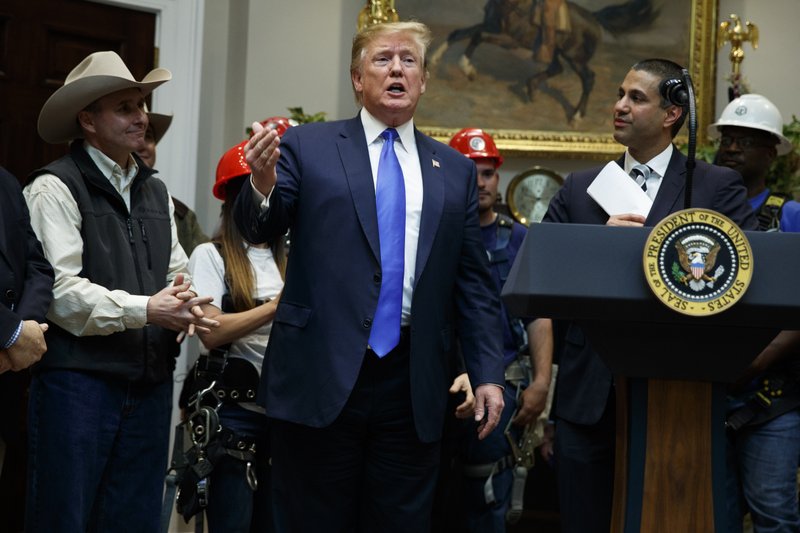President Donald Trump's administration and government regulators unveiled a major push Friday afternoon at the White House to accelerate the rollout of the high-speed, next-generation mobile data technology known as 5G.
Under the plan, the Federal Communications Commission will release a broad area of high-frequency airwaves for cellular use in what will be the largest trove of U.S. wireless spectrum ever to be auctioned off. As much as 3.4 gigahertz of so-called millimeter-wave spectrum could be sold to wireless carriers such as AT&T and Verizon in the sale, which will begin Dec. 10, according to FCC Chairman Ajit Pai.
The FCC also will propose a $20 billion fund to expand broadband in rural America over the coming decade, connecting up to 4 million households and small businesses to high-speed Internet, said Pai. The Rural Digital Opportunity Fund could debut later this year after a period of public notice and comment.
Speaking at the White House, Trump argued that the nation could not allow "any other country to outcompete the United States" in the race to 5G, and vowed that it is a race America would win.
"No matter where you are, you will have access very quickly to 5G, and it's going to be a different life," he said in remarks at the White House. "I don't know if it's going to be better -- maybe you're happy right now -- but I'm going to say, technologically, it won't even be close."
The two proposals reflect the most intensive effort of the Trump era to close the "digital divide" and gain an edge in the global race to build a fully functioning, nationwide 5G network. Proponents say the advances that 5G offers over 4G will eventually enable mobile download speeds of up to 1,000 megabits per second -- roughly 100 times faster than the current standard -- and pave the way for new technologies such as self-driving cars and virtual reality.
The $20 billion broadband initiative, said Pai, would be funded using "repurposed" money from within the Universal Service Fund, a federal aid program that indirectly supports a wide range of subsidies, including low-income phone service, lower-cost broadband access for schools and libraries and rural broadband deployment. Only one Universal Service Fund program would be affected by the new Rural Digital Opportunity Fund, the FCC said: Connect America Fund II, a broadband program that last year held an auction to disburse $2 billion in infrastructure funding over 10 years. Money for the Universal Service Fund is raised by fees that carriers add to consumer phone bills.
Despite his focus on auctioning spectrum, Pai's critics say his 5G strategy has overlooked or even caused setbacks in other areas of policy.
"So far this Administration's interventions on 5G have done more harm than good," Jessica Rosenworcel, a Democratic FCC commissioner, tweeted Friday. "From imposing tariffs on 5G equipment to alienating allies on 5G security to falling behind the rest of the world on critical mid-band spectrum, it has yet to offer a workable plan for U.S. leadership."
Friday's announcement comes in the face of rising competition from China and other nations that are moving swiftly to develop 5G technology.
Pai was among a group of U.S. officials who, at an industry conference in February, pressured allies to stop using wireless networking gear from Chinese companies such as Huawei over fears that the equipment could enable Chinese eavesdropping. In the meetings, the Trump administration's European partners largely acknowledged the risk but disagreed with the U.S. delegation on how to mitigate the threat.
The upcoming airwaves auction is not the first of the 5G era. Since November, the FCC has sold off more than 1.5 gigahertz in spectrum licenses for 5G, according to agency figures. The high-frequency waves are considered ideal for 5G because they can carry a great deal of data very reliably, albeit at the cost of range and the ability to penetrate walls and other obstacles.
Of the three chunks of millimeter waves to be sold in the upcoming auction, two -- in the 37 gigahertz and 47 gigahertz bands -- are currently unoccupied, according to the FCC. The remaining chunk, in the 39 gigahertz band, is already controlled in some portions by AT&T and Verizon. On Friday, the FCC kicked off its process for designing the auction protocols in its monthly meeting.
Industry groups welcomed the twin announcements.
"WISPA hails the intensified focus on bettering rural connectivity, which will help country farmers receive the same evolving level of broadband services and connectivity as city financiers," said the Wireless Internet Service Providers Association, in a statement.
Millimeter waves are not the only kind of airwaves suitable for 5G. Carriers such as T-Mobile and Sprint have focused their 5G efforts on medium-frequency, or midband, airwaves, and have made it a centerpiece of their argument for a $26 billion merger. Midband spectrum offers less capacity than the higher-band alternatives, but can cover greater distances.
Pai said Friday that he is committed to making airwaves of all types a priority.
Business on 04/13/2019
